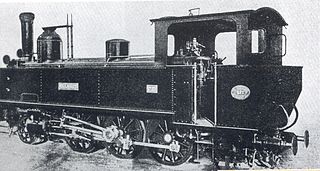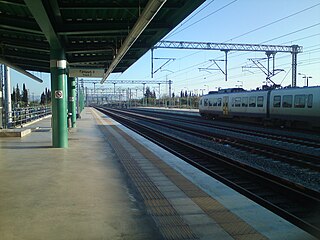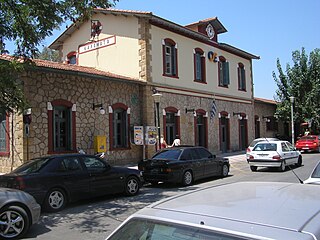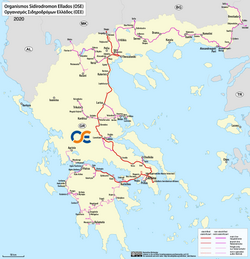
Transport in Greece has undergone significant changes in the past two decades, vastly modernizing the country's infrastructure and transportation. Although ferry transport between islands remains the prominent method of transport between the nation's islands, improvements to the road infrastructure, rail, urban transport, and airports have all led to a vast improvement in transportation. These upgrades have played a key role in supporting Greece's economy, which in the past decade has come to rely heavily on the construction industry.

The Proastiakos is Greece's Commuter rail service, run by Hellenic Train, on rail infrastructure owned by the Hellenic Railways Organisation (OSE) (lines) and GAIAOSE. These services connect a participating city's central railway station to important locations such as a city's port or airport, as well as its suburbs and occasionally nearby towns and cities.

The Hellenic Railways Organisation or OSE is the Greek national railway company which owns, maintains and operates all railway infrastructure in Greece with the exception of Athens' rapid transit lines. Train services on these lines are run by Hellenic Train S.A., a former OSE subsidiary, Rail Cargo Logistics Goldair, Pearl and Grup Feroviar Român.

Piraeus is the name of two railway stations in Piraeus, Athens, Greece, approximately 9 km south-west of the centre of Athens. The southern building is an interchange station between Line 1 and Line 3 and is the present terminus of Athens Metro Line 1, formerly the Athens-Piraeus Railways Co that opened in 1869. The northern building is the railway terminus for standard gauge railway services of the Athens Suburban Railway to the Acharnes Railway Center and Chalcis. Both buildings are located next to the seaport, with the Electric Railways Museum of Piraeus located in the metro station, in the space of the former Post Office.

Piraeus, Athens and Peloponnese Railways or SPAP was a Greek railway company founded in 1882 as private company until its nationalization, which owned and operated the 1,000 mm Piraeus–Patras railway line connecting Piraeus and Athens to Peloponnese. The company was nationalized in 1954 and absorbed by the Hellenic State Railways in 1962.

Athens–Lavrion Railway was a 1,000 mmmetre gauge railway line connecting downtown Athens with Eastern Attica and the mining town of Lavrion in Greece.

Hellenic Train S.A., formerly TrainOSE S.A., is a private railway company in Greece which operates passenger and freight trains on OSE lines. Hellenic Train employs train crews, operators and manages most of the rail services throughout the Greek railway network, leasing rolling stock owned by GAIAOSE except for ETR 470 trains.

Kiato railway station is a station in Kiato in the northern Peloponnese, Greece. The station is located 1 km west of the town, near the A8 motorway between Athens and Patras. It was opened on 9 July 2007. The station is served by the Athens Suburban Railway towards Piraeus and Hellenic Train local services to Aigio. It should not be confused with the now-closed station on the old Piraeus–Patras railway, which is located northeast of the current station, closer to the coast of the Corinthian Gulf.

Athens railway station is the main railway station of Athens, and the second largest station in Greece. Located in the central quarter of Kolonos, the railway station resulted from the merger of two separate railway terminals in 2005—Larissa station of the Piraeus–Platy railway towards central and northern Greece, and the Peloponnese station of the Piraeus–Patras railway that formerly linked Athens with the Peloponnese.

The railway from Piraeus to Platy is an electrified double-track railway line that connects Athens to northern Greece and the rest of Europe. It constitutes the longest section of the mostly completed higher-speed rail line known as P.A.Th.E./P., which includes Greece's most important rail connection, that between Athens and Thessaloniki. Its northern end is the station of Platy, on the Thessaloniki–Bitola railway. In the south, it connects to the Athens Airport–Patras railway at the Acharnes Railway Center. The line passes through Thebes, Katerini and Larissa, and offers connections to several other cities through branch lines.

The railway from Athens Airport to Patras is a double-track, standard-gauge railway line in Greece that, when completed, will connect Athens International Airport with Patras, the country's third-largest city. One of the largest railway projects of the last 30 years in Greece, its completion is of major significance for the infrastructure of the entire region of the northern Peloponnese. As of 2020, the line is completed until the city of Aigio. A 5.2 km underground section is planned for the final section from Kastellokampos to Agios Andreas in Patras. For most of the section between Athens Airport in East Attica and Mandra in West Attica, the line runs along the median strip of the Attiki Odos motorway.

The railway from Piraeus to Patras was a 230-kilometre long metre-gauge railway line in Greece that connected the port of Athens, Piraeus with Patras in the Peloponnese peninsula, via Athens "Peloponnese" central station and Corinth. It was opened between 1884 and 1887. Formerly one of the main lines of the Greek railway network, it has now largely fallen into disuse. It has mostly been replaced by the Athens Airport–Patras railway, a new standard-gauge line whose first section opened in 2004 and which remains under construction between Aigio and Patras. The 13 km section between Piraeus and Agioi Anargyroi, a northern suburb of Athens, has since been removed and replaced by the corresponding section of the upgraded Piraeus–Platy railway. As of 2020, the only sections in operation are the 22.5 km section between Agioi Anargyroi and Eleusis, and the 7.3 km section between Rio and Patras.

The Athens Suburban Railway, is a commuter rail service that connects the city of Athens and its metropolitan area with other places in Attica, Boeotia, Corinthia and the city of Chalcis in Euboea.

Patras railway station is a railway station in Patras in the northwestern Peloponnese, Greece. The station is located in the center of the city, beside the north port on Piraeus–Patras line and Patras–Kyparissia line and is severed by both Proastiakos Patras Services. Pending the completion of the Athens Airport–Patras railway, it is also the starting point of TrainOSE bus lines to Aigio, Diakopto and Kiato, where connecting train services to Athens Airport and Piraeus are available. Diakopto is also the terminus of the unique rack railway to Kalavryta.

Kalamata railway station is a disused railway station in Kalamata, Greece. located within the city itself. Opened 1892 by the Piraeus, Athens and Peloponnese Railways. Until 2010 TrainOSE operated local and regional services to Katakolo, Pyrgos and Olympia and Kyparissia, and a suburban service to Messini and the General Hospital. At present, it is served by excursion trains while remaining inactive on other routes, but the area houses the open-air railway park, with several railway exhibits. Previously Piraeus, Athens and Peloponnese Railways operated a narrow gauge service to Athens from Kalamata.

Rouf railway station is a station on the Piraeus–Platy railway line in Rouf, a neighbourhood of Athens, located on the borders of the municipalities of Athens and Tavros. Originally opened on 30 June 1884 it was rebuilt to serve Athens Suburban Railway lines when this section came into operation in June 2007. It owes its name to the area of Rouf, named after a Bavarian businessman who once owned the land in the 19th Century.

Rentis railway station is a station on the Piraeus–Platy railway line in Agios Ioannis Rentis, a suburban town in the Piraeus regional unit. Originally opened on 30 June 1884 it was rebuilt to serve the Athens Suburban Railway lines when this section came into operation in June 2007. It owes its name to the area of Agios Ioannis Rentis, shortened to just Rentis.
Lefka railway station is a station on the Piraeus–Platy railway line in Piraeus, Athens. Originally opened on 30 June 1884 it was rebuilt to serve the Athens Suburban Railway lines when this section came into operation in June 2007.
Xylokastro railway station is a station in Xylokastro, a seaside town in Corinthia, Greece. It is located just south of Xylokastro, close to the Olimpia Odos motorway. It was opened on 22 June 2020 as part of the €848-million ErgOSE project extension of the Athens Airport–Patras railway to Aigio rail line, co-financed by the European Union's Cohesion Fund 2000–2006. The station is served by Hellenic Train local services between Kiato and Aigio. It should not be confused with the now-closed station on the old Piraeus–Patras railway, which is located northeast of the current station, closer to the coast of the Corinthian Gulf.

Diakopto railway station is located just north of Diakopto, Achaea, Greece. Originally opened on 10 March 1896, it was reopened on 22 June 2020 as part of the Hellenic Railways Organisation's €848-million project extension of the Athens Airport–Patras railway to Aigio, co-financed by the European Union's Cohesion Fund 2000–2006. The station is currently served by both the unique rack railway to Kalavryta and Hellenic Train local services between Kiato and Aigio.




































